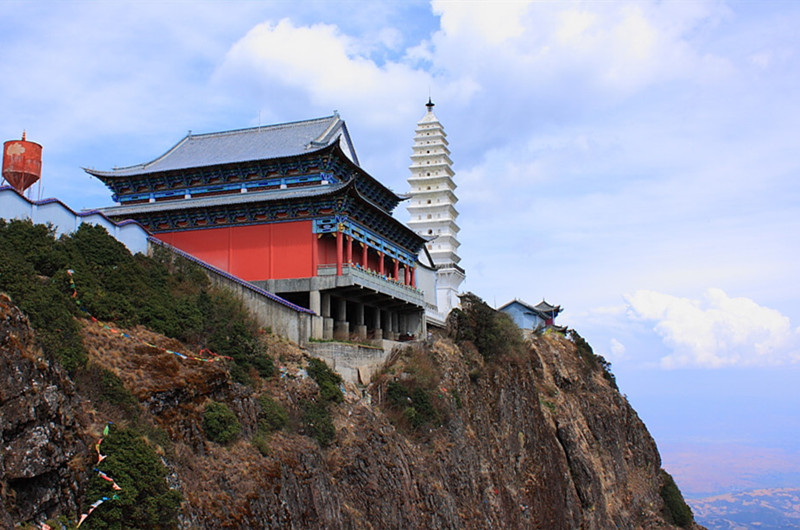Lengyan Pagoda (楞严塔) is located on the summit of Tianzhu Peak (天柱峰) of Jizushan (鸡足山) in the northwest of Binchuan County (宾川县), Yunnan Province (云南省). It is listed as a second batch prefectural-level key cultural relic protection unit in Dali Prefecture (大理州).
Jizushan is a sacred Buddhist mountain in Southeast Asia, a national-level scenic area, and a convergence point of Chinese Han Buddhism and Tibetan Buddhism, as well as a birthplace of Chan (Zen) Buddhism. It is said to have been a practice site founded by Mahākāśyapa, one of Śākyamuni’s foremost disciples. The mountain was named “Chicken Foot Mountain” because its peaks and ridges resemble a chicken’s foot.
The original site of Lengyan Pagoda was once occupied by the Ming dynasty Guangming Pagoda (光明宝塔), which was destroyed during the reign of Emperor Kangxi in the Qing dynasty. In 1932, Long Yun (龙云), then Governor of Yunnan Province, initiated reconstruction, and the new pagoda was completed in 1934.

Architecture
The pagoda is a thirteen-story dense-eaved hollow square tower, standing over 40 meters tall. Inside, seven levels can be accessed (though now closed to the public). Its exterior design imitates the Qianxun Pagoda (千寻塔) of Chongsheng Temple (崇圣寺), but with a more slender profile.
The second tier features an iron-railed observation corridor, supported by eight inverted triangular structures on each side, forming a distinctive “skirt hem” decoration at the base—an architectural detail blending traditional Buddhist style with a modern aesthetic.
During the Second Sino-Japanese War, Lengyan Pagoda served as a navigation marker for the Hump Route, playing a unique role in wartime transportation.
Cultural and Historical Significance
Lengyan Pagoda preserves several important inscriptions, including Zhou Zhongyue’s (周钟岳) Stele Inscription of Lengyan Pagoda on Jizushan, Yang Mengnan’s (杨萌南) Stele Record of Lengyan Pagoda on Jizushan, and Long Yun’s (龙云) Dignity of the Dharma.
Although built in the 20th century, the pagoda inherits and develops the traditional style of Dali Buddhist towers, marking the continuation of a thousand-year-old pagoda-building tradition in the region.
Scenic Value

From afar, Lengyan Pagoda resembles a giant scholar’s brush standing atop the golden summit of Jizushan, serving as a prominent landmark visible for hundreds of kilometers. Its appearance changes with the seasons—surrounded by blooming azaleas and camellias in spring, floating above a sea of clouds in summer, framed by clear skies and greenery in autumn, and gleaming in the snow in winter.
Visitors at its base can gaze upward to see clouds swiftly passing the tower’s pinnacle, evoking awe at the grandeur of Chinese architecture. From its vantage point, one can view Cangshan (苍山) and Erhai Lake (洱海), watch the sunrise in the east, admire colorful clouds to the south, overlook the western waters, and see Yulong Snow Mountain (玉龙雪山) to the north.
Famed traveler Xu Xiake (徐霞客) once marveled that from Tianzhu Peak, one could enjoy “the four wonders”—eastern sunrise, western sea, southern clouds, and northern snow—each of which was already rare to see individually, but here all united in one place.
Present Status
Today, the interior of Lengyan Pagoda is closed to visitors, but its striking silhouette and the way it harmonizes with the surrounding mountains continue to inspire admiration. This pagoda stands not only as a historical monument but also as a spiritual symbol, proudly overlooking Dali and the “Land South of the Clouds” (彩云之南).

 7 Days GolfingTour
7 Days GolfingTour
 8 Days Group Tour
8 Days Group Tour
 8 Days Yunnan Tour
8 Days Yunnan Tour
 7 Days Shangri La Hiking
7 Days Shangri La Hiking
 11 Days Yunnan Tour
11 Days Yunnan Tour
 6 Days Yuanyang Terraces
6 Days Yuanyang Terraces
 11 Days Yunnan Tour
11 Days Yunnan Tour
 8 Days South Yunnan
8 Days South Yunnan
 7 Days Tea Tour
7 Days Tea Tour
 8 Days Muslim Tour
8 Days Muslim Tour
 12 Days Self-Driving
12 Days Self-Driving
 4 Days Haba Climbing
4 Days Haba Climbing
 Tiger Leaping Gorge
Tiger Leaping Gorge
 Stone Forest
Stone Forest
 Yunnan-Tibet
Yunnan-Tibet
 Hani Rice Terraces
Hani Rice Terraces
 Kunming
Kunming
 Lijiang
Lijiang
 Shangri-la
Shangri-la
 Dali
Dali
 XishuangBanna
XishuangBanna
 Honghe
Honghe
 Kunming
Kunming
 Lijiang
Lijiang
 Shangri-la
Shangri-la
 Yuanyang Rice Terraces
Yuanyang Rice Terraces
 Nujiang
Nujiang
 XishuangBanna
XishuangBanna
 Spring City Golf
Spring City Golf
 Snow Mountain Golf
Snow Mountain Golf
 Stone Mountain Golf
Stone Mountain Golf
















